Q&A – Ask Neil: May 25, 2023
(Please read these instructions carefully.)
Before you post your question, please look at recent issues to see if someone else has already asked it. You might find your answer there.
How to submit your question…
• Click the link provided below to post your question. After you submit your question, a new window will pop up giving you the address to which you can e-mail a sharp, high-resolution photo to accompany your question. Please do not send thumbnail photos in case I need to zoom in to see things.
• Click here to post your question.
• Please only post your question one time. We can only accept a set number of questions each week, and when we get duplicates it costs other people their chances.
• One question per reader, please.
• Please use this only for posting questions – not for standard emails.
• Watch for your answer in the following week’s e-gardens.
• I choose those of greatest general interest. For example, plant IDs seldom make the cut.
• I must have your first name or initials.
• I must have your city or county. (Texas is a very large state.)
QUESTION 1
WHY ARE MY JUNIPERS DYING BACK ON TOP?
Question: Why are my junipers losing branches on top? There is good, healthy growth on top, but the lower branches are turning brown. I’ve kept the dog away and I raised them a bit higher than the surrounding soil. Is this a disease? Antoinette H., Keller.
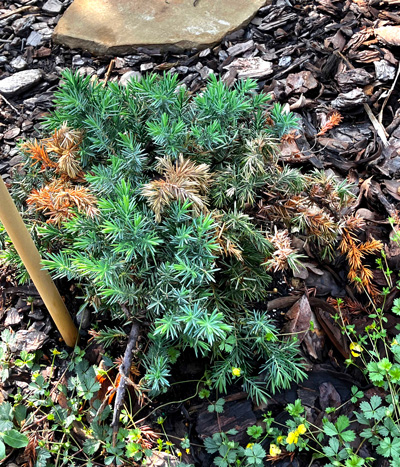
Answer: Yes. I believe it’s a disease. Probably one of the several juniper twig blights. They are difficult to stop with the various junipers. Here are several of the best write-ups from agricultural universities. I hope this helps. You could also send a sample to the Plant Disease Diagnostic Laboratory at Texas A&M in College Station. They do charge for culturing samples, but they could identify the pathogen in the lab for you and prescribe the best hope of controlling it. https://hgic.clemson.edu/factsheet/juniper-diseases-insect-pests/; https://hortsense.cahnrs.wsu.edu/fact-sheet/none-recommended/; and a very good explanation from Walter Reeves, retired horticulturist from the University of Georgia Extension Service: https://www.walterreeves.com/landscaping/juniper-phomopsis-tip-blight/. Phomopsis is quite common and very damaging to many species of junipers.
QUESTION 2
HOW CAN I CONTROL THIS WEED?
Question: I’m not sure what this weed is, so I don’t know how to control it. I’ve tried using a plant ID app and it’s given me crabgrass, a sedge and thin paspalum, among others. If it’s crabgrass, is pre-emergent the only control? Natalie P., Fort Worth.
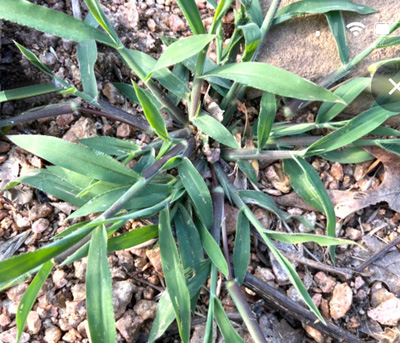
Answer: I think your ID of thin paspalum may be correct. Its distinguishing characteristic is the evenly spaced hairs along the edges of its leaves. Your photos are low resolution and I can’t tell for sure, but I think I’m seeing the hairs. See this information from Virginia Tech: https://weedid.cals.vt.edu/profile/559
As for control, it’s a perennial grass, so pre-emergent herbicides won’t have much impact on it. Your main means of getting rid of it will be to apply a glyphosate-only herbicide with a pump sprayer directly to each clump and runner. The glyphosate will kill desirable grasses, too, so treat before it invades the better parts of your lawn. You can carefully treat beneath shrubs and in beds.
QUESTION 3
WHY IS MY LAWN ALWAYS YELLOW IN THIS AREA?
Question: Every year I have a problem with my St. Augustine getting yellow spots in this area. I do fertilize it. What is happening? Mark., Flint.
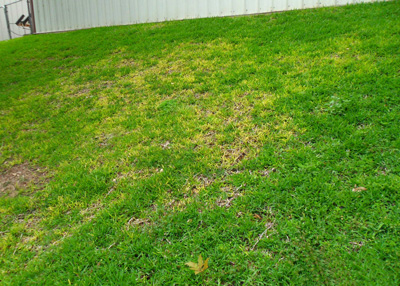
Answer: That surely looks like the take all root rot (TARR) you’ve seen me write about here over the past two months. The fungicide Azoxystrobin is the only product available to consumers that is labeled for stopping this disease. We used to recommend applying 1 inch of sphagnum peat moss to put a thin layer of acidic material in which the disease would be repressed, but pathologists later decided that the fungicide gave better long-term control. It should help your lawn green up going into the summer. TARR is less of a problem in hot weather anyway, so it will get double benefit from the fungicide and better weather at the same time.
QUESTION 4
SHOULD I APPLY IMIDACLOPRID TO PREVENT CHINCH BUGS THIS YEAR?
Question: I had significant chinch bug damage to my zoysia lawn last summer A treatment with bifenthrin put an end to it, but I’m wondering if I should use a systemic insecticide like Imidacloprid this year as a preventive measure? Justin J., Austin.
Answer: In St. Augustine management, I let the turf tell me when chinch bugs come back to their annual summer homes. (They always return to the hottest, sunniest parts of the lawn.) When I notice the grass looking dry in those areas, and when I water and when the grass fails to perk back up by the following morning, I know that it’s time to check for the small black insects with irregular white diamonds marking each of their backs. That’s when I recommend apply Imidacloprid. However, if you travel and might not be there to watch, or if it’s more difficult for you to see that subtle change in your zoysia, apply the Imidacloprid a week before the date that you treated last year.
QUESTION 5
WOULD THE VIBURNUM BE A CONSIDERATION FOR REPLACEMENT OF DISEASED REDTIP PHOTINIAS?
Question: Would the viburnum be a consideration for replacement of diseased redtip photinias? Richard P., Colleyville.
Answer: You didn’t specify which viburnum, but I’m going to say “No” to your question. The evergreen viburnums aren’t especially suited to Texas weather and the deciduous types would be bare 5 months out of the year – not good for a privacy screen. I love them all, but just not for that use. I would definitely suggest one of the taller hollies: Willowleaf (to 8-12 ft., also sold as Needlepoint), Nellie R. Stevens (to 12 to 18 ft.). Oakland hollies are more upright, but a bit slower growing, eventually reaching 10 to 12 ft tall and 5 or 6 ft. wide.
QUESTION 6
WHAT IS WRONG WITH THESE LIMBS ON MY BUR OAK?
Question: My beautiful bur oak has several limbs that are distressed. Can you diagnose? Nixie R., Ellis County.

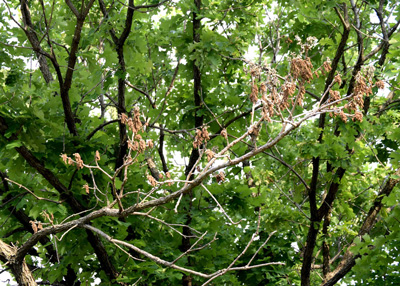
Answer: I can’t tell with any certainty. A certified arborist needs to climb the tree and inspect it closely. Notice all the short, vigorous branches coming off the trunk part way up. They indicate that something is wrong in the trunk, and whatever that problem turns out to be is causing the limbs to turn brown. Some of them will probably start to fall before long, so don’t sit or park beneath them. I suspect there is active decay on one side of the trunk. If so, you’ll need to have the arborist deal with it soon.
QUESTION 7
IS THERE A GOOD GROUNDCOVER TO FILL UP OUR FLOWERBEDS? THEY ARE CONSTANTLY FULL OF WEEDS.
Question: We have flowerbeds in the front that are constantly full of weeds. Is there a good groundcover to plant that will fill up the flowerbeds and be green year ‘round? Julie B., Royce City.
Answer: I’m scared to answer your question! Nothing is worse than weeds in a groundcover bed. How ‘bout we get rid of the weeds, then plant the best groundcover. Take samples of the weeds to a Texas Certified Nursery Professional to have them identified as to whether they are annuals or perennials and whether they are broadleafed or grasses. There will be the perfect product to get rid of any. Then you’ll be able to plant any groundcover you want, not just a strong-growing one that could become invasive in its own right.
QUESTION 8
WHY IS MY BLOODGOOD JAPANESE MAPLE GREEN ON THE BOTTOM AND RED ON THE TOP?
Question: My Bloodgood Japanese maple is red on the top and green on the bottom. What would cause this and will it change? Steve R., Arlington.
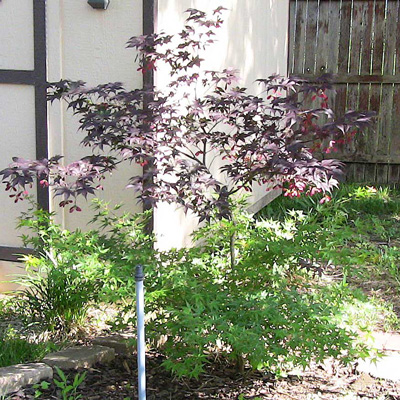
Answer: Like all improved varieties of Japanese maple, Bloodgood is grafted onto a seedling rootstock. You are seeing growth from that green-leafed rootstock. You really do not want that to develop. Take your pruning shears out with you and trace the green growth back to the main trunk. Clip and remove it at that point.
QUESTION 9
IS THERE A PARTICULAR BRAND OF AZOXYSTROBIN YOU RECOMMEND FOR TARR?
Question: You recommend Azoxystrobin for control of TARR. Is there a particular brand? Mike C., Dallas.
Answer: I’ve always made it my practice not to single out companies, whether they are advertisers or not, as I answer people’s gardening questions. I just don’t think it’s good journalism. However, if only one company has a product, I will identify them. In this case, it is Scotts, and they call the product “Disease-EX.”
QUESTION 10
SHOULD TEXAS SAGE BE PRUNED TO ENCOURAGE NEW GROWTH?
Question: When our house was built in 2021 the landscapers planted Texas sage way too close to the house. We recently had them moved, but they didn’t take the transplanting well. Now it looks like we need to cut them back to the new growth down below. Is that a good idea? Melody P., Lake Weatherford.
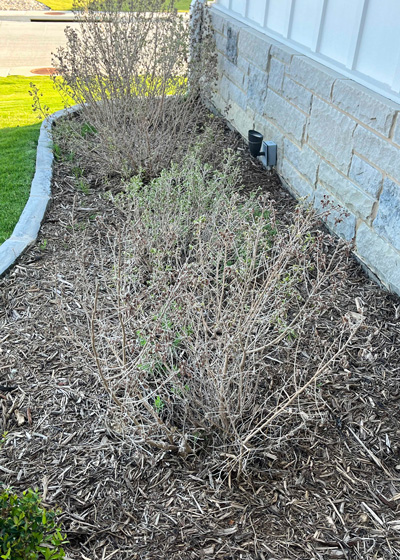
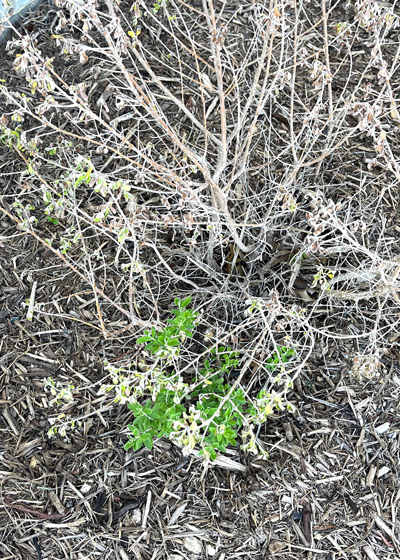
Answer: It looks like it would help them recover. I would also apply an all-nitrogen fertilizer along with a heavy soaking.
That’s the answer to the question you asked. The answer to the question you didn’t ask (where I step out on a limb) is that they are very vulnerable to cold damage where you live. When I first saw your photos, I thought the plants had just frozen back like 95 percent of the Texas sage plants in the Metroplex did after February 2021 and December 2022. They’ve been brutalized twice. And, if you ever decide to replace them, you might think about using a dark green shrub like dwarf Burford holly that would give you a nice contrast against the gray of your house.
